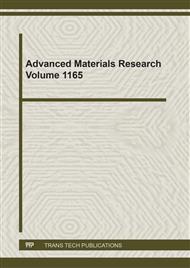[1]
Ma ZY. Friction stir processing technology: a review. Metallurgical and Materials Transactions A, 39(3):642–658, (2008).
Google Scholar
[2]
Mishra RS and Ma ZY. Friction stir welding and processing. Materials science and engineering: R: reports, 50(1-2):1–78, (2005).
DOI: 10.1016/j.mser.2005.07.001
Google Scholar
[3]
Thomas WM, Nicholas ED, Smith SD. Friction Stir Welding-Tool Developments. In: Das SK, Kaufman JG, Lienert TJ, editors. Aluminum 2001-Proceedings of the TMS 2001 Aluminum Automotive and Joining Sessions; 2001, pp.213-224.
Google Scholar
[4]
Thomas W. International patent application no. pct/gb92. GB Patent Application No. 9125978., (1991).
Google Scholar
[5]
Dawes CJ, Threadgill PL, Spurgin EJR, Staines DG. Development of the New Friction Stir Technique for Welding Aluminum-Phase II. TWI Member Report 1995; 5651/35/95.
Google Scholar
[6]
Dawes CJ and Thomas WM. Development of improved tool designs for friction stir welding of aluminium. In Proceedings of the First International Conference on Friction Stir Welding, pages 2–6, (1999).
DOI: 10.31399/asm.hb.v06a.a0005629
Google Scholar
[7]
Thomas WM, Johnson KI, and Wiesner CS. Friction stir welding–recent developments in tool and process technologies. Advanced Engineering Materials, 5(7):485–490, (2003).
DOI: 10.1002/adem.200300355
Google Scholar
[8]
Zettler R, Lomolino S, Dos Santos JF, Donath T, Beckmann F, Lippman T, and Lohwasser D. A study on material flow in FSW of AA 2024-T351 and AA 6056-T4 alloys. In 5th International FSW Symposium-Metz, France, pages 14–16, (2004).
DOI: 10.1007/bf03266474
Google Scholar
[9]
Colegrove PA and Shercliff HR. Development of trivex friction stir welding tool part 1 - twodimensional flow modelling and experimental validation. Science and Technology of Welding and Joining, 9:345–351, 08 (2004).
DOI: 10.1179/136217104225021670
Google Scholar
[10]
Colegrove PA and Shercliff HR. Development of trivex friction stir welding tool part 2–threedimensional flow modelling. Science and Technology of Welding and Joining, 9(4):352–361, (2004).
DOI: 10.1179/136217104225021661
Google Scholar
[11]
He X, Gu F, and Ball A. A review of numerical analysis of friction stir welding. Progress in Materials Science, 65:1–66, (2014).
DOI: 10.1016/j.pmatsci.2014.03.003
Google Scholar
[12]
Watanabe T, Takayama H, and Yanagisawa A. Joining of aluminum alloy to steel by friction stir welding. Journal of Materials Processing Technology, 178(1-3):342–349, (2006).
DOI: 10.1016/j.jmatprotec.2006.04.117
Google Scholar
[13]
Coelho RS, Kostka A, Dos Santos JF, and Kaysser-Pyzalla A. Friction-stir dissimilar welding of aluminium alloy to high strength steels: Mechanical properties and their relation to microstructure. Materials Science and Engineering: A, 556:175–183, (2012).
DOI: 10.1016/j.msea.2012.06.076
Google Scholar
[14]
Xue P, Ni DR, Wang D, Xiao BL, and Ma ZY. Effect of friction stir welding parameters on the microstructure and mechanical properties of the dissimilar Al–Cu joints. Materials science and engineering: A, 528(13-14):4683–4689, (2011).
DOI: 10.1016/j.msea.2011.02.067
Google Scholar
[15]
Uzun H, Dalle Donne C, Argagnotto A, Ghidini T, and Gambaro C. Friction stir welding of dissimilar Al 6013-T4 to X5CrNi18-10 stainless steel. Materials & design, 26(1):41–46, (2005).
DOI: 10.1016/j.matdes.2004.04.002
Google Scholar
[16]
Mofid MA, Abdollah-Zadeh A, and Ghaini FM. The effect of water cooling during dissimilar friction stir welding of Al alloy to Mg alloy. Materials & Design (1980-2015), 36:161–167, (2012).
DOI: 10.1016/j.matdes.2011.11.004
Google Scholar
[17]
Mofid MA, Abdollah-Zadeh A, Ghaini FM, and Gür CH. Submerged friction-stir welding (SFSW) underwater and under liquid nitrogen: an improved method to join Al alloys to Mg alloys. Metallurgical and Materials Transactions A, 43(13):5106–5114, (2012).
DOI: 10.1007/s11661-012-1314-2
Google Scholar
[18]
Karakizis PN, Nasioulas EC, Chionopoulos S, and Pantelis D. The effect of dry ice cooling on the microstructure of dissimilar friction stir welds between aluminum and magnesium. 6th ICMEN International Conference, 10 (2017).
Google Scholar
[19]
Ferrando WA. The concept of electrically assisted friction stir welding (EAFSW) and application to the processing of various metals. Technical report, Naval Surface Warfare Center Carderock DIV Bethesda MD Survivability Structures and Materials Directorate, (2008).
DOI: 10.21236/ada487182
Google Scholar
[20]
Liu X, Lan S, and Ni J. Electrically assisted friction stir welding for joining al 6061 to trip 780 steel. Journal of Materials Processing Technology, 219:112–123, (2015).
DOI: 10.1016/j.jmatprotec.2014.12.002
Google Scholar
[21]
Santos TG, Miranda RM, and Vilaca P. Friction stir welding assisted by electrical joule effect. Journal of materials processing technology, 214(10):2127–2133, (2014).
DOI: 10.1016/j.jmatprotec.2014.03.012
Google Scholar
[22]
Shaffer D, Grimm TJ, Ragai I, and Roth J. Utilization of XSYTIN-1 tool in electrically-assisted friction stir welding of dissimilar metals-Al 6061-T651 to mild steel. In Advanced Materials Research, volume 1152, pages 31–41. Trans Tech Publ, (2019).
DOI: 10.4028/www.scientific.net/amr.1152.31
Google Scholar
[23]
Jayabalakrishnan D and Balasubramanian M. Friction stir weave welding (FSWW) of AA6061 aluminium alloy with a novel tool-path pattern. Australian Journal of Mechanical Engineering, (2017).
DOI: 10.1080/14484846.2017.1373584
Google Scholar
[24]
Jayabalakrishnan D and Balasubramanian M. Effect of square wave tool path pattern on mechanical and microstructure properties of friction stir welded AA6061-Cu dissimilar alloys. J Chin Soc Mech Eng, 40(6):711–717, (2019).
DOI: 10.17222/mit.2021.202
Google Scholar
[25]
Jayabalakrishnan D and Balasubramanian M. Eccentric-weave FSW between Cu and AA6061-T6 with reinforced graphene nanoparticles. Materials and Manufacturing Processes, 33(3):333–342, (2018).
DOI: 10.1080/10426914.2017.1339323
Google Scholar
[26]
Hirasawa S, Badarinarayan H, Okamoto K, Tomimura T, and Kawanami T. Analysis of effect of tool geometry on plastic flow during friction stir spot welding using particle method. Journal of materials processing technology, 210(11):1455–1463, (2010).
DOI: 10.1016/j.jmatprotec.2010.04.003
Google Scholar
[27]
Lambiase F, Paoletti A, and Di Ilio A. Forces and temperature variation during friction stir welding of aluminum alloy AA6082-T6. The International Journal of Advanced Manufacturing Technology, 99(1-4):337–346, (2018).
DOI: 10.1007/s00170-018-2524-6
Google Scholar


